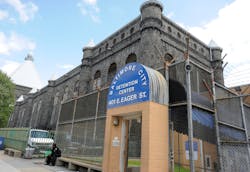Embattled Baltimore Jail Touts Security Improvements
Seven months after the Baltimore City Detention Center was thrust into the national spotlight as a haven for corruption, state corrections officials made the case Thursday that a series of reforms have significantly improved safety at the 150-year-old facility.
A long-sought phone-jamming technology system is nearing activation. A network of 230 high-definition cameras has been installed with a nerve center in the office of new jail administrator Ricky Foxwell. Corrections officers now pass through heightened security checks when they clock in for work.
"I think we're well on our way," Foxwell said as he showed reporters through the jail.
It was the first extensive public look at the facility since the April indictments of 25 people -- 13 of them corrections officers -- in a federal case that said Black Guerrilla Family gang members had taken over the jail.
But observers said Thursday that the jail has a long way to go before it sheds the stigma of the corruption scandal. Salacious details of the reputed leader impregnating four corrections officers propelled the case into international news and led critics to question state corrections leadership.
"The problems developed over decades, and solving or attempting to solve them is something that rightfully is taking a bit of time to do right," said state Del. Guy Guzzone, a Howard County Democrat who is one of the chairs of a legislative inquiry into the jail. "There isn't an easy fix here."
Waiting outside the facility, relatives of inmates groused that the jail had only been fixed up for the tour. And Archer Blackwell, a representative for unionized corrections workers, agreed that the changes are largely superficial.
"Nothing has changed significantly," he said. "They paint over rusted bars and still have a lot of overcrowding. They spruce it up when someone is coming through."
Officials point to a slew of new policies and procedures. Though two inmates were stabbed last week in a day room, statistics show assaults are down. In the six months before the indictment, there were 289 reports of smuggled contraband, and there have been 168 such reports in the six months since then. For the calendar year, 275 contraband items have been found, down from 737 the previous year.
Asked whether the jail can be contraband-free, state Public Safety and Correctional Services Secretary Gary Maynard replied, "I'd like to see one that is."
But the new leadership at the facility, which includes agency veteran Casey Campbell and retired Howard County police officer Eric Brown, say they're focused on the details in an effort to cut down on a lax culture that allowed violations to occur.
"If we sweat the small stuff, the big stuff doesn't happen," Campbell said.
Blackwell, of the officers' union, said fallout from the Black Guerrilla Family case has led to tough scrutiny of officers that is not always fair. "They feel the tension of being under scrutiny. They can't relax and do their jobs like they should," Blackwell said.
The crumbling facility -- built two years before Abraham Lincoln was sworn in as president -- is one of the busiest of its kind in the country.
The halls and cell bars appeared freshly painted Thursday in white, gray and black, and the floors were spotless. Officials allowed reporters to walk down the hall and peer into cells of the so-called working men, inmates paid to assist management and allowed to move about the facility.
The FBI said the gang had controlled contraband smuggling by co-opting such men, and Foxwell said officials now more closely screen inmates chosen for the program.
Two men sharing a tiny cell and bunk bed on the working men tier said it gets cold at night. But "it's not too bad," they said.
By January, Foxwell said the facility also hopes to open a dining room, located in a building that once housed juveniles charged as adults. After The Baltimore Sun reported on dangerous conditions for those juveniles, the detainees were moved into a different building.
For years, inmates have eaten in their cells. Foxwell was asked by reporters if having inmates congregate in a large room could become a problem, but he said he viewed it as another way to cut down on contraband. Foxwell said inmates were delivering the food, pushing carts through the facility and dropping off smuggled items into cells.
Maynard said more indictments of corrections officers could be coming, a statement he has made before. But he said he feels confident that officials have a handle on the problems.
"We have the tools and the staff to deal with it pretty quickly," he said.
twitter.com/justin_fenton
Copyright 2013 - The Baltimore Sun
